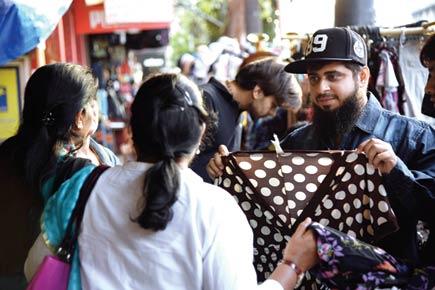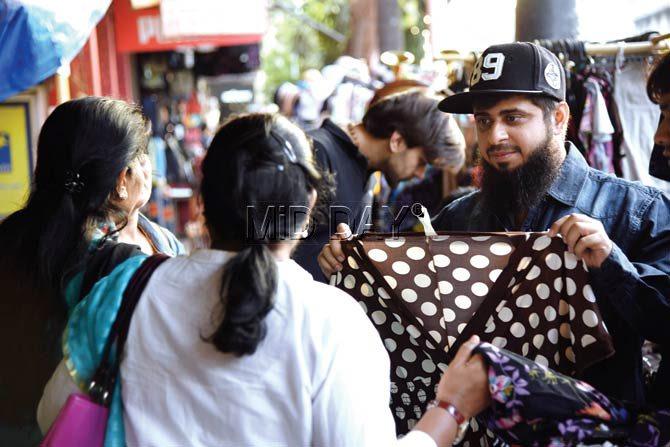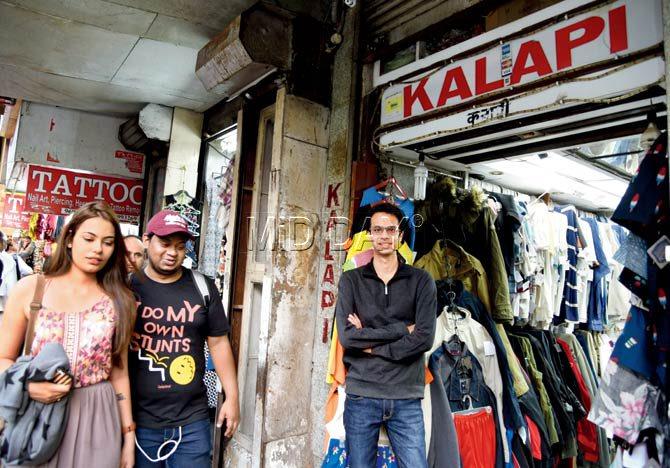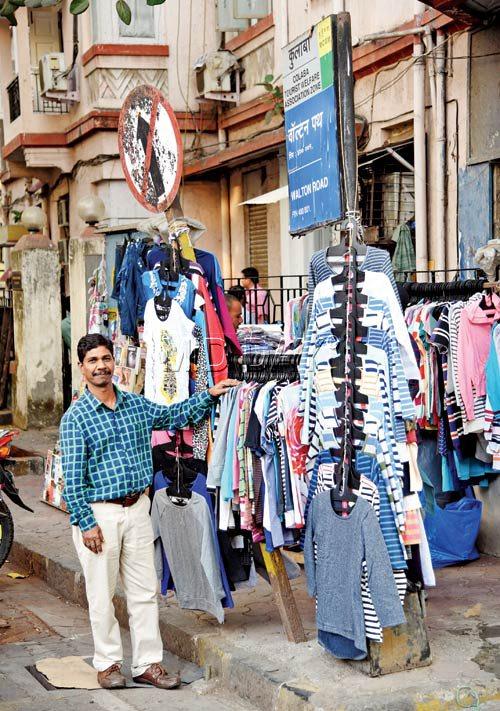BMC corruption, globalization and lure of synthetics have sounded the death knell for two of Mumbai's globally-famed thrifting hotspots Colaba Causeway and Fashion Street

There is an unmistakable pall of gloom hanging over Fashion Street on MG Road near Metro cinema. "Abhi tak boni bhi nahin hua hoga. (Some of us haven't even made our first sale)," says Vivek from Stall no 67. It's 2.30 pm, three hours after he opened for business. This is reason to worry.

Unlike earlier, exclusivity of stock is lost at most stalls including Akbar Memon’s at Colaba Causeway, leaving shoppers disinterested. Because he can’t travel to export surplus units that have shifted out of Mumbai, middle agents come to him with truckloads of the same maal they offer others to choose from. PIC/SAMEER MARKANDE
ADVERTISEMENT
It wasn't always like this. Whether you were fashion forward, fashion experimental, broke backpacker or bored, when in south Mumbai, you had to head to this destination and Colaba Causeway, five kms away, for a quick clothing fix. Both these stretches were famous for their cheap but fashionable export surplus garments sold out of licenced stalls since the late 1970s and early '80s They feature on every guidebook and canny tourists know not to pack any cotton clothes for long-term stay in India — they can just buy them from the tourist district when they visit the Gateway of India.
In a time when high street and fashion labels were still unknown in India, as recent as six years ago, you could rely on Causeway and FS to serve 'export ka maal' from Promod, Mango, Benetton, Gap, Old Navy, Zara and labels yet unheard. At a time when the finest mul and cotton was exported and couldn't be found in the Indian market, you could rely on landing a peasant top at Causeway.
If you were a veteran, like stylist Isha Bhansali, you would head to Ramji (Saroj) at Stall 66 to get your fix of silk dresses, pants, tops and kimonos — all 'sample maal' which meant, nobody else would have it. If you knew your stuff, you'd recognise the neon bodycon dress from Christopher Kane for TopShop and grab it for under Rs 500. There have been eye-witness reports (by this journalist) of an exquisite, fully beaded, sample-size wedding gown sold for Rs 2,000 at Stall no 96. If you wanted to test-drive a trend, you'd ask Rashid who sat outside Kalapi on Causeway to show you midi-rings, bodychains and ear cuffs. Rashid would take a bite out of your dabba and happily model a minimalist maang tika for you.

Brick and mortar shops like Kalapi, owned by Wesley Kalapi (centre in pic), survive due to large inventories. Their customers include not just walk-ins but boutique owners from Ethiopia, South Africa, Nigeria and the UK who buy in wholesale. Pics/Sameer Markande
Now, Bhansali hasn't been there in eight months. Another stylist, who used to go to FS twice a month, says she stopped because her style matured and she'd rather buy basic pieces that last, once in two months for a higher price. "I'm too old to wear cats on a shirt or synthetic material which doesn't suit our weather," she says.
Each stall had a speciality — Stall no 76 stocked UK labels TopShop and ASOS; Stall no 66 did beaded and sequinned 'party wear'; Stall no 96 did outrageous sample pieces of the like worn by high priestesses; and Stall no 46 was where you went for cotton tops, including the recurring 'chaddi-shirt' — a shirt with swimsuit bottoms that kept it tucked into your pants. On Causeway were the mul tunics. Yusuf outside the Bata showroom kept tees, tanks and hoodies. The guys just before the petrol pump near Souvenir toy store had chiffon dresses, jumpsuits and tops.
Then something changed. Somewhere two years ago, everyone started stocking the same things. Export surplus disappeared and was replaced by garments made for the 'local market'. Synthetic materials such as polyester, which were thus far untouchables in this market, made an entry. Accessories were routed from China and Bangkok. Stall no 96 shut down; Stall no 66 moved to a shop in Malad; Rashid now has his own shop in Dubai.
It was the beginning of the end. Now, only Stall no 76 represents export surplus.
"Everyone has the same stuff. I used to first go for statement neckpieces and tribal themed accessories. And the guy near Café Leopold would have these cool T-shirts back when we were growing up," says Scherezade Shroff, former model who has her own fashion channel on YouTube. Shroff lives just off Causeway and would invariably make a detour when something caught her eye as she went in and out of her home. She has not shopped at FS in six months and does not wander to Causeway unless she needs something specific — a pair of Kolhapuri chappals, maybe. "I shop more at Sarojini Nagar now; it has better variety. The price-points at these stalls have also gone up and you can get the same thing online or at Forever 21 at the same price. There is no bargaining range; now you play 'the game' with yourself." She's referring to the bargaining waltz where you quote a price and walk ahead disinterestedly if the vendor refuses. Ninety-seven per cent of the time, they would call you back to give you the piece at your price. When one would expect new stuff every week or every few days, now the 'maal' is updated less often than once a month.

Former model Scherezade Shroff, who has her own fashion channel on YouTube, says what one could buy at Causeway or Fashion Street earlier, can be bought online or at Forever 21 at the same price
Multi-pronged hit
Ask the vendors what went wrong and they say the blows came from every direction. Factories that made export surplus moved to faraway Bangalore, Ludhiana, Tirupur, Sri Lanka and Bangladesh. No longer is the 'seth' who owns the stall able to smuggle out cartloads of surplus from the factory in Dadar, Parel or Santacruz. Many of these 'factories' were sweatshops in the shanties near the airport, in Dharavi and other industrial hubs which have now relocated or broken down after stricter implementation of international manufacturing laws. The 'seth' guards his or her relationship with a factory from the salespersons at the stall. "Ab pehle jaisa maal aata hi nahin hai (we don't get the same stock as before)" is the common refrain. "Factories, jahan sau surplus pieces banate the, ab pachaas banate hain (Factories used to make 100 surplus pieces now make 50)," says Pavitra Nair of Stall no 125 at FS. Because brands once popular at the stalls now have a presence in India, the old or surplus stock is routed to online vendors or brick-and-mortar export surplus shops in big and small cities. Stall vendors have therefore had to stock up on clothes made for the local market or cheap (synthetic) stock from China and Bangkok.
Where the profit margin on a cotton garment is Rs 50, it's Rs 100 to Rs 150 on a synthetic one. In the hey days, the profit margin was still Rs 50, but they sold a lot more pieces.
"Pehle jaisi girhaki bhi nahin hai (The customer does not spend as much as before)" is the second most repeated complaint. "Ab sab jaga same maal milne laga hai, toh koi yahan kyun aye? (Now the same stuff is available everywhere. Why would people come here?)," says Rajesh Tiwari of Stall no 124. He is right. Bangkok and China import is available outside every railway station and main street in the suburbs. "Our main client was the foreigner. They had the taste for these kind of clothes," says Ramji Gupta who owned Stall no 66. He shut it one-and-a-half years ago and moved to a brick-and-mortar store in Malad with his daughter at the cash counter. "The foreigners have stopped coming here now. Aur ab sabko export ka shauk bhi nahin raha (Now people don't like export goods anymore)." He is also talking about store-owners from South Africa and Greece who would buy wholesale from him. Gupta's relationship with his factory supplier is strong, so no other stall would have his wares.
In Malad, he stocks the same clothes but pays a rent of just Rs 20,000 per month. Here, he can sell clothes at fixed price. The casualty of this move has been the loss of salespeople like Ram and Kishore, who manned his stall for 22 years. They live in Mankhurd and Wadala respectively and travelling to Malad would mean three train changes. They now man 'gaothan clothes shops' in Nerul and Panvel.
Less money circulating in the shops means a lower kitty to buy new stock. Only a few owners can now travel to Tirupur or Bangalore to buy it. Those who can't — such as Akbar Memon of a stall outside Rajsi Bros and Co. at Electric House, and Ram Murti Patel on Causeway — depend on middle agents who come with truckloads to choose from. Thus exclusivity is lost.
Stores such as Kalapi and Cotton Colours on Causeway are able to survive because of their deep pockets. They have the space to have larger inventories and since they buy goods by the truckload, the factories are happy to sell exclusively to them. "We have three stores," says Wesley Kalapi, whose sister handles the popular Pax next door. The stores have been here for 30 and 25 years respectively. The owners of Cotton Colour are also from the same family. Their clientele includes not only walk-in shoppers, but boutique owners from Ethiopia, South Africa, Nigeria and the UK who buy in wholesale.
Civic struggle
Then there is the constant strife with the BMC. Till 1997, hawkers sat on both sides of the pavement on FS, creating a shopping tunnel. Only one side is legal, which puts at peril those walking around or selling their wares on the road. "Some of us have been here for 15 years," say a man who sells women's trinkets. "We should be licenced by now." Every time a BMC van passes — and it happened twice in the three hours taken to conduct the interviews — these vendors run to hide their ware in the stalls. Stallwallahs will crane their necks to predict fate — if the van is in the first (fast) lane, they are safe.
"The BMC is not clear on its policy," says A Ward corporator Sushma Vinod Shekhar. "When they confiscate goods, it's from both licenced and unlicenced vendors. They should have a clear policy on display rules too."

Mahesh Paras says display rules by BMC are a spoiler. Rods that stretch out on to the road are not strictly legal.
Rods that stretch out on to the road are not strictly legal. The stalls can also be fined for littering. Those with rods making a rectangle on Causeway, like Mahesh Paras', have been shortened. Residents complain that some of the newer stalls, like the ones on JA Allana Road and Henry Road cause traffic congestion when customers pool around them. Strictly speaking, the hawkers are allowed to display wares only on their stall, folded up. "Export ki cheez display nahin karenge, toh dikhegi kaise? (If we don't display our wares, how can customers see them?) We understand the nuisance it can cause and keep the place clean," says Ram Murti Patel, who has manned the stall outside Just In Time store on Causeway since 1978.
Licence raaj
Nobody talks about the unspoken rift created by the infiltration of a new strain of unlicenced hawkers who come from the hometown of a local politician named in the 1993 bomb blasts. They follow the "Gulf method of export" with one brother in China, Bangkok or Taiwan routing wares to stores here. They have been accused of boarding up small passages between buildings, turning them into 'shopping plazas'. Residents are afraid these pose a security risk as even those who go to photograph the stores are threatened. There was an instance of a false case of molestation lodged against a 65-year-old resident who went to complain about one such vendor at Colaba police station.
Local ALM Clean Heritage Colaba Residents Association (CHCRA) has been asking the BMC to relocate the hawkers. "They can be housed in special zones or hawking plazas, utilising malls that are not doing well," says Subhash Motwani, president of CHCRA. "Causeway is a VIP area. The stalls are cleared at the time of a VIP visit. They block the footpath in the evenings and create traffic congestion on the corners. The material [wares for sale] also poses a fire hazard."
The residents feel that the buck is being passed between the police and the BMC. Since the hawkers sit on the pavement, they fall within BMC domain. Because they pose a 'security threat', the BMC believes it's a police problem. What is not questioned is money changing hands each time a raid is conducted and goods seized.
And what about the shopping?
"I would go to Fashion Street to get that unique fun piece, which maybe I wouldn't even wear — like a denim kediyu. Pieces that would make you smile," says Bhansali. "And to Causeway for basics — cotton shirts and tunics. Even those would have something special like a hi-and-low hem. It was also a place to check out how runway trends were translated into shop pieces. Maybe this is just a low phase?"
Our wardrobe hopes so.
 Subscribe today by clicking the link and stay updated with the latest news!" Click here!
Subscribe today by clicking the link and stay updated with the latest news!" Click here!







